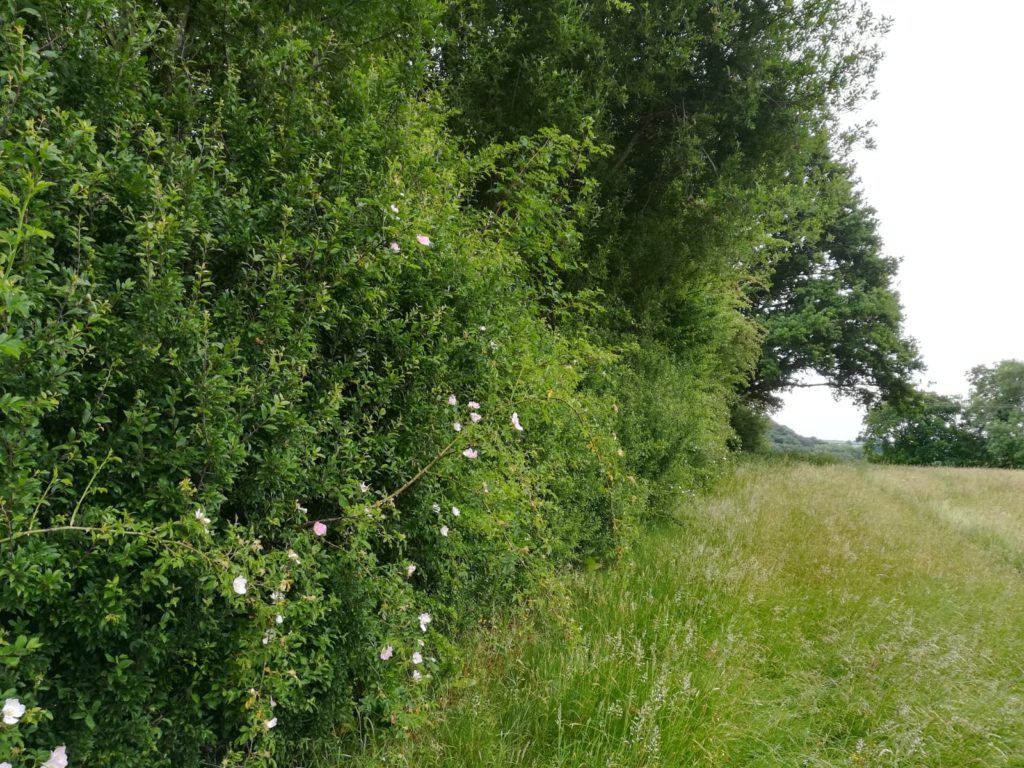Emily Warner laments the erosion of the wild hedgerows and fields where she grew up.

When I walk from my parents’ house these days, I turn left at the top of the lane more often than right. For years we would walk the other way, towards the white cottage, where we would usually turn for home. There was a special appeal to this route, a feeling of wildness, following a lane that runs to nowhere. Views to the distant hills forming a long ridge on the horizon as we headed towards our destination, seeming more distant than it was, hidden by the neglected hedgerows that divided up the fields.
Alongside the feeling of remoteness, there was a sense that these fields and lanes were inhabited and enjoyed. In late winter, lapwings would twist and turn in their display flight above the bare fields, calling to each other in otherworldly clicks and whistles. As spring moved on, we would stand, shading our eyes, seeking the tiny dots of skylarks singing their way up into the blue sky. On May evenings, we would cycle through the lanes, swooping gently through the soft and scented dusk, bats zipping ahead of us and cow parsley wafting in the hedgebanks.
An old man farmed these fields. We would see him sometimes, and rarely anyone else. He lived alone in a cottage overshadowed by a row of conifers, set within an orchard with apple trees grown old and gnarled beyond the age of productivity. An ageing pony and a solitary sheep seemed to live beside his house, kept as pets or company perhaps. In a rusting tractor he would chug slowly up the lane, his collie crouched balancing in the cab beside him or running ahead to the field gate. The land was not farmed intensively, and the livestock that grazed the fields seemed kept on almost out of an age-old habit.
Who knows if the old farmer valued the towering hedgerows, where hazel and blackthorn formed tunnels over the lanes. I would admire their complexity: hawthorn, hazel, blackthorn, field maple, the occasional oak or ash thrusting upwards. All interwoven and entangled with a mass of honeysuckle, bindweed and wild rose, galls hanging off in psychedelic pink and green masses. The pastures were overgrown and tussocky, and occasionally we would hear the call of a curlew from somewhere out of sight.
Sometime, a handful of years ago, a little while after I had left home, the famer died. He had worked there for most of his life and until the last of his days, perhaps unknowingly achieving a surprising harmony with nature and his surroundings. The farm changed hands, and in quite a short time that change became apparent. One winter’s day, when I was back at home, we went for the same walk, and could hear across the fields the grinding cry of metal on wood. In the fields, tractors were at work, disk saws spinning as they cut through those towering hazel hedges that lined the lanes. Deeper in the fields we could see the internal hedgerows being stacked as piles of brush. The trees over-hanging the farmhouse and nearby cottages were cut back.
It is possible now, at the beginning of our walk, to look straight over those fields. The farmhouse which we could never see does not appear distant at all. We can see more, but the walk seems diminished, without the protective hedgerows, alongside fields crammed with maize and no sight of a lapwing nor sound of a curlew. So instead of turning right at the lane head, we tend to turn left, on a walk where we still might find tunnels of trees and fragrant hedgerows bursting with life.
I feel a sense of grief for those memories and for that walk, once a favourite. The rest of my family walk that way more often than I do, more pragmatic in their acceptance that things will change. A walk in my company, whatever the route, will be accompanied by my despairing acknowledgement of a mown road verge, a tree cut down, a hedgerow uprooted. Each change may seem insignificant, often going unnoticed, yet incrementally they stack up. By almost every indicator we are failing the UK’s wildlife, pushing it from the edges of the landscape that we allow it to occupy. Yet it doesn’t need to be this way — and I feel that if everyone could share just a fraction of my sorrow for these losses, then perhaps they would no longer happen.
*
Emily Warner an ecologist who is increasingly concerned by the erosion of nature at every scale. She is currently studying for a PhD, assessing the effect of reforestation on biodiversity and ecosystem function, with a particular focus on native reforestation in the Scottish Highlands. You can follow her on Twitter here.